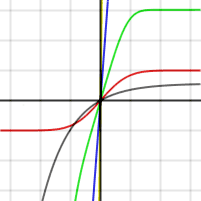Error function
|
|
In mathematics, the error function (also called the Gauss error function) is a non-elementary function which occurs in probability, statistics and partial differential equations. It is defined as:
- <math>\operatorname{erf}(x) = \frac{2}{\sqrt{\pi}}\int_0^x e^{-t^2} dt.<math>
By expanding the right-hand side in a Taylor series and integrating, one can express it in the form
- <math>\operatorname{erf}(x)= \frac{2}{\sqrt{\pi}}\sum_{n=0}^\infin\frac{(-1)^n x^{2n+1}}{(2n+1)n!} =\frac{2}{\sqrt{\pi}} \left(x-\frac{x^3}{3}+\frac{x^5}{10}-\frac{x^7}{42}+\frac{x^9}{216}-\ \cdots\right)<math>
for every real number x.
The complementary error function, denoted erfc, is defined in terms of the error function:
- <math>\mbox{erfc}(x) = 1-\mbox{erf}(x) = \frac{2}{\sqrt{\pi}} \int_x^{\infty} e^{-t^2}\,dt\,.<math>
The complex error function, denoted w(x), is also defined in terms of the error function:
- <math>w(x) = e^{-x^2}{\textrm{erfc}}(-ix).<math>
| Contents |
General theory
The error function is essentially identical to the standard normal cumulative distribution function, denoted Φ, as they differ only by scaling and translation. Indeed,
- <math>\Phi(x) = \frac{1}{2}\Big[1+\mbox{erf}\Big(\frac{x}{\sqrt{2}}\Big)\Big]\,.<math>
The standard normal cdf is used more often in probability and statistics, and the error function is used more often in other branches of mathematics.
When the results of a series of measurements are described by a normal distribution with standard deviation σ, then erf(a/(σ√2)) is the probability that the error of a single measurement lies between -a and +a.
By analytic continuation, the error function can be defined for complex arguments as well. It occurs, for example, in solutions of the heat equation when boundary conditions are given by the Heaviside step function.
The integral defining the error function cannot be evaluated in closed form in terms of elementary functions, but the integrand may be expanded in a power series and integrated term by term. Values of the integral, as functions of x, have been tabulated.
Some authors discuss the more general functions
- <math>E_n(x) = \frac{n!}{\sqrt{\pi}} \int_0^x e^{-t^n}dt
=\frac{n!}{\sqrt{\pi}}\sum_{p=0}^\infin(-1)^p\frac{x^{np+1}}{(np+1)p!}\,.<math>
E2(x) is the error function.
Graph of generalized error functions En(x). Grey curve: E1(x)=1-e-x, red curve: erf(x)=E2(x), green curve: E3(x), blue curve: E4(x), and yellow curve: E5(x). (The yellow curve is quite close to the y-axis and may not be visible.) After division by n!, all the En for odd n look similar (but not identical) to each other. Similarly, the En for even n look similar (but not identical) to each other after division by n!. The En with odd and even n look similar on the positive x side of the graph.
Asymptotic expansion
A useful asymptotic expansion of the complementary error function (and therefore also of the error function) for large x is
- <math>\mathrm{erfc}(x) = \frac{e^{-x^2}}{x\sqrt{\pi}}\left [1+\sum_{n=1}^\infty (-1)^n \frac{1\cdot3\cdot5\cdots(2n-1)}{(2x^2)^n}\right ]=\frac{e^{-x^2}}{x\sqrt{\pi}}\left [ 1+\sum_{n=1}^\infty (-1)^n \frac{(2n)!}{n!(2x)^{2n}}\right ]\,.<math>
This series diverges for every finite x. However, in practice only the first few terms of this expansion are needed to obtain a good approximation of erfc(x), whereas the Taylor series given above converges very slowly.
Related functions
The error function is a special case of the Mittag-Leffler function, and can also be expressed as a confluent hypergeometric function. It has a simple expression in terms of the Fresnel integral.
References
- Milton Abramowitz and Irene A. Stegun, eds. Handbook of Mathematical Functions with Formulas, Graphs, and Mathematical Tables. New York: Dover, 1972. (See Chapter 7) (http://www.math.sfu.ca/~cbm/aands/page_297.htm)
External links
- MathWorld - Erf (http://mathworld.wolfram.com/Erf.html)de:Fehlerfunktion

